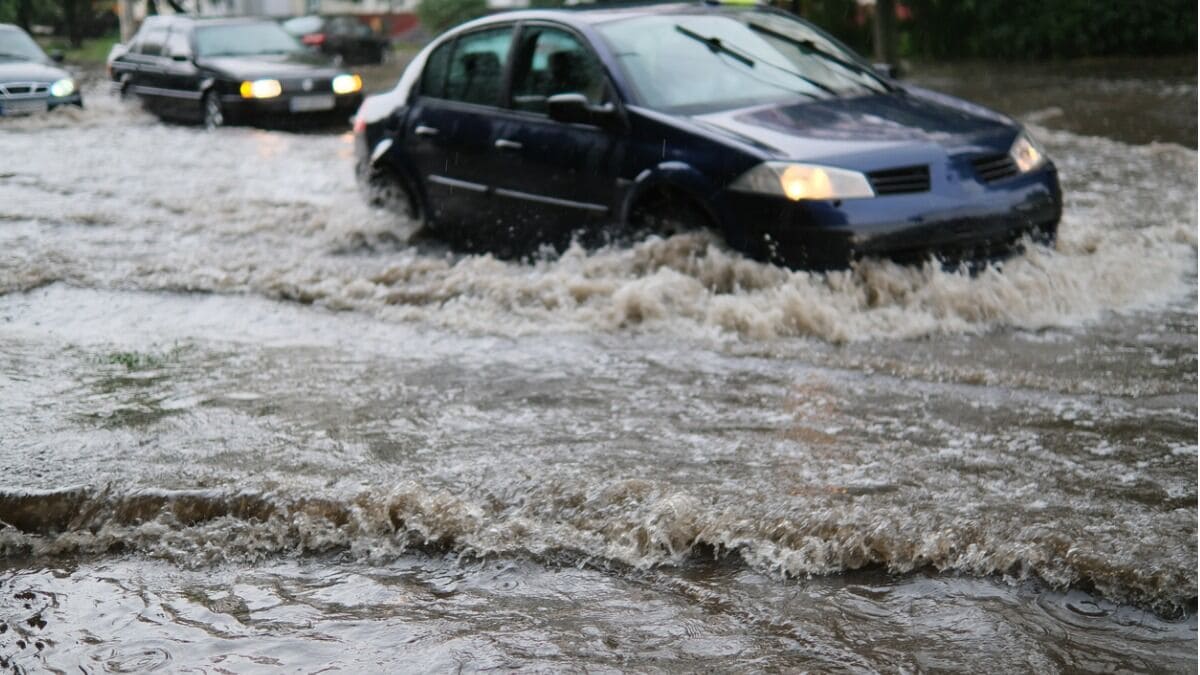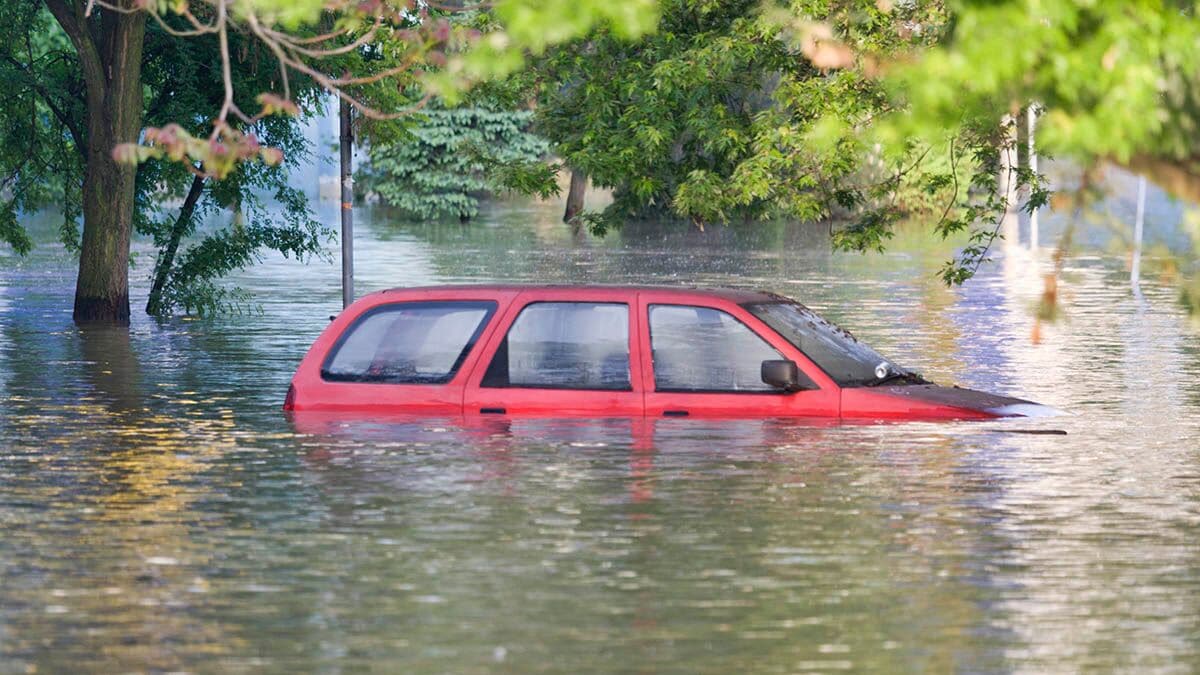Last Updated: 07/18/2025
Car Damaged in a Disaster: Essential Tips
Insurance data and disaster reports indicate hundreds of thousands of vehicles are destroyed or damaged yearly by hurricanes, hail, floods, wildfires, and tornadoes. This data does not consider non-weather-related events such as accidents, car fires, and, you may be surprised to learn, bears and other wildlife.
Here are some steps to take if your car is damaged or totaled in a disaster.
Safety First
You and your loved ones’ safety is the priority before worrying about your vehicle.
Assess your surroundings:
- After a natural disaster: Be aware of ongoing risks like rising water, downed power lines, or unstable structures. Follow the guidance of emergency officials.
- After an accident or fire: Get out of traffic or any immediate danger, such as leaking fuel
- After an animal encounter: Keep a safe distance if the animal remains nearby.
- Call 911 if anyone is injured or if it’s a hazardous scene.
Document the Damage and Don’t Touch
Documenting the accident scene and resulting damage can provide critical evidence to support an insurance claim:
- When it is safe, use your phone to take pictures and videos of the damage from every angle, both wide and close shots.
- Take pictures and videos of the surrounding area. If you had an accident with another vehicle, take photographs and video of their damage and license plate.
- Do not attempt to start a flood-damaged car. Starting the engine can cause severe, irreparable damage and impact your insurance claim. Take caution that a flooded electric vehicle could suddenly catch fire.
- Don’t alter the scene other than addressing immediate safety concerns. You might be unwittingly tampering with evidence.
- If warranted, file an official police report.
Contact Your Insurance Company
As soon as feasible, file a claim with your car insurance and arrange an inspection. The sooner you report the damage, the sooner your insurer can process your claim. Keep your policy number accessible in your vehicle, on your device, and online. Many providers have apps to store your profile information. You may be able to file a claim online, through your insurance agent, or the insurer’s website.
Here are contact phone numbers for some of the major insurers:
State Farm: Call your agent or 1-800-732-5246
Progressive: 1-800-776-4737
Geico: 1-800-841-3000
Allstate: 1-800- 255-7828
USAA: 1-800-531- 8722
Liberty Mutual: 1-844-349-8391
Farmers: 1-800-435-7764
Travelers: 1-800- 252-4633
Nationwide: 1-800-421-3535
American Family Insurance: 1-800-692-6326
- Understand your policy. Comprehensive coverage typically covers most non-collision events: natural disasters (hurricanes, hail, floods), fire, theft, vandalism, and animal damage.
- Ask Key Questions:
- Rental car coverage options?
- Is my car repairable or a total loss?
- Will the payout include car taxes, title, and registration fees?
- Where does the check go if you financed your car? To you, or the lender/lessor?
- Follow your claims adjuster’s instructions. The adjuster will inspect your vehicle and guide you through the process.
- Beware of scams involving unsolicited tow truck operators or repair shops that contact you directly.
- If a major disaster declaration occurs, you may qualify for federal assistance for uninsured or underinsured transportation needs. You must apply through the Federal Emergency Management Agency (FEMA).
- Learn your car’s pre-disaster market value. Use your vehicle identification number (VIN) to determine what your car is worth on Kelley Blue Book.
- The Small Business Administration (SBA) may also be able to help with a low-interest loan for work vehicles.
- If your insurer totals your car, remove license plates, toll tags, and insurance cards, and erase your data from the infotainment system, if possible. Don’t forget to take your garage door openers, Apple AirTags, or telematics devices.
- Keep detailed records, including claim number, receipts, a log of all communications with your insurer and all those videos and photos
What About an EV?
- The same advice holds when it comes to documentation and insurance.
- Due to the high-voltage battery, additional safety concerns arise in flooding and water (especially salt water) situations.
- Salt water can cause a chemical reaction where the battery can spontaneously catch fire days or weeks after exposure.
- Assume the entire EV is energized. Do not attempt to touch it or drive it. Isolate the car, if possible, at least 50 feet from any structures or combustible materials, and keep your distance.
- Let anyone who comes to help you know immediately that you have a flooded electric vehicle.
- If they have to tow your EV, insist on a flatbed.
Other Considerations
- After your car is repaired or replaced, hold onto all your documentation for at least five years.
- Add comprehensive car insurance to your policy if you don’t have it. If you own or lease a new car, consider GAP (Guaranteed Asset Protection) coverage, which helps pay off your loan or lease if the insurance payment or Actual Cash Value (ACV) is less than what you owe.
- Pay attention to weather forecasts and warnings and, if possible, move your car out of harm’s way before major events.
Additional Resources
- https://www.disasterassistance.gov/
- https://www.ready.gov/
- https://www.iii.org/
- Your State’s Insurance Department
Quick Reference Checklist
| Done? | Step |
| ☐ | Get everyone to safety and secure the scene |
| ☐ | Photograph/video damage thoroughly |
| ☐ | Contact insurance and start a claim |
| ☐ | Contact your lender/lessor if financed or leased |
| ☐ | Apply to FEMA / SBA if needed |
| ☐ | Remove plates and personal data if totaled |
| ☐ | Review insurance coverage going forward |
| ☐ | Retain all disaster records |
Related Content

Totaled Car: Everything You Need to Know
When your vehicle gets totaled, it can be a stressful situation. Our guide will help you navigate what to do if you total your car.

Flood-Damaged Cars: How to Spot and Avoid Them
When extreme weather hits and floods destroy, the destruction often includes water-damaged cars. Here’s what to know about them.

Is It Safe to Drive a Car Damaged in a Flood?
Learn essential tips for handling flood-damaged vehicles, icluding insurance advice, safety precautions, and how to spot hidden damage after severe weather.

What to Do if Your Car Is Flooded: 8 Steps You Must Take
Car sitting in floodwater? Learn the 8 critical steps — from safety to insurance claims — to minimize damage and avoid costly mistakes in 2025.

Car Lift: Ways to Protect Your Car From a Flood
Quick Facts About Car Lifts Whether rain, mountain snow melt, or a hurricane causes water to rise in your area,…

Winter Survival Guide for Drivers: Prepping Your Car for the Cold
Quick Tips About Driving in Winter Weather If you live in a region with harsh cold and heavy snowfall in…

Driving in Snow: Top Tips You Need
Quick Facts About Driving in Snow, Ice, and Other Winter Weather Use these tips for safe driving in snow and…

Are Winter Tires Worth the Cost?
Many drivers have the misconception that a winter tire’s sole benefit over an all-season tire is better traction in the…

Snow Tires Guide: Everything You Need to Know
Snow Tires Quick Tips The phrase “where the rubber meets the road” describes the moment you put a theory to…

Should Traction Control Be On or Off in Snow?
Quick Tips for Traction Control in Snow Winter driving can challenge even the most seasoned drivers experienced in navigating snowy,…

Best Cars for Snow
See our list of the best cars and SUVs for driving in snow and the options and safety features you need when choosing a vehicle for winter.